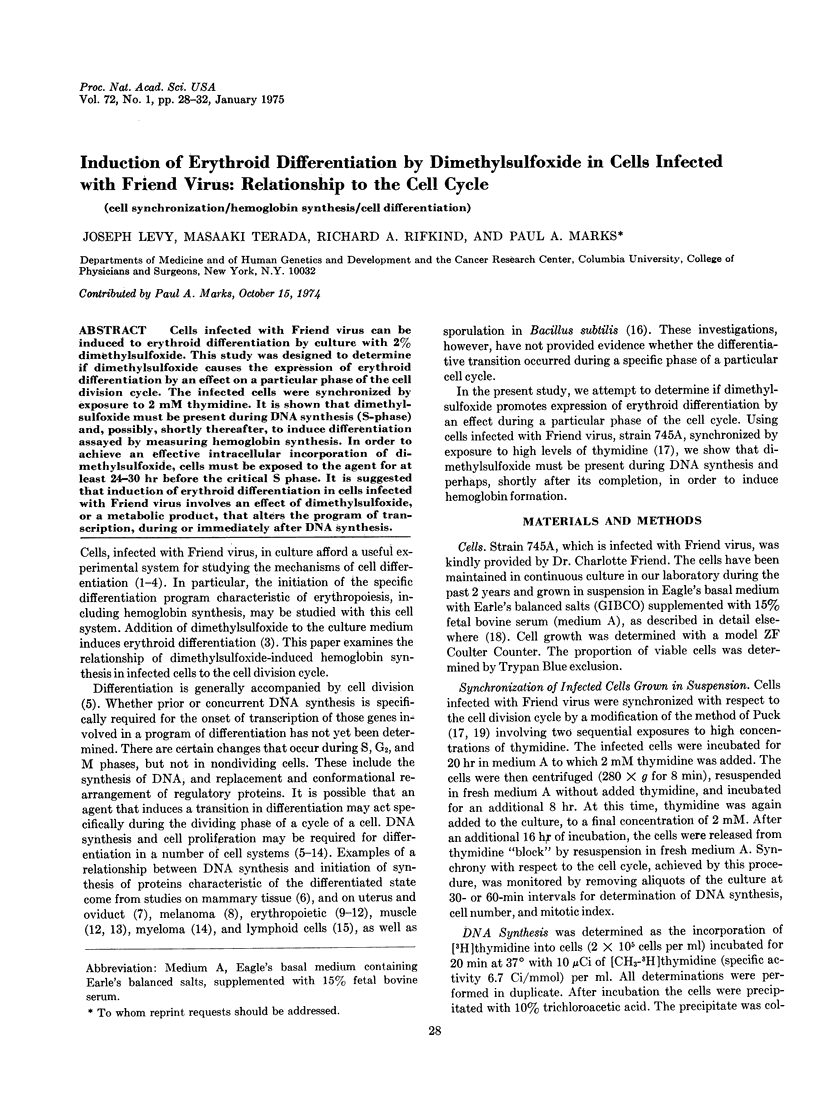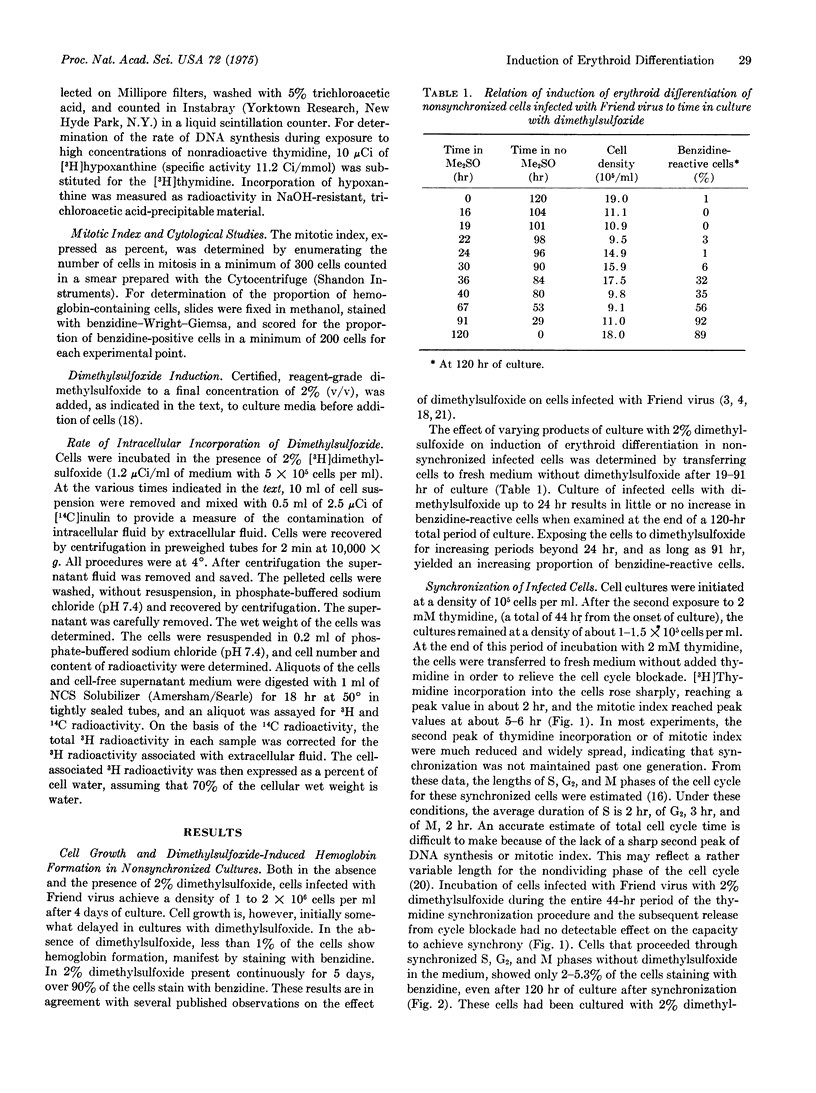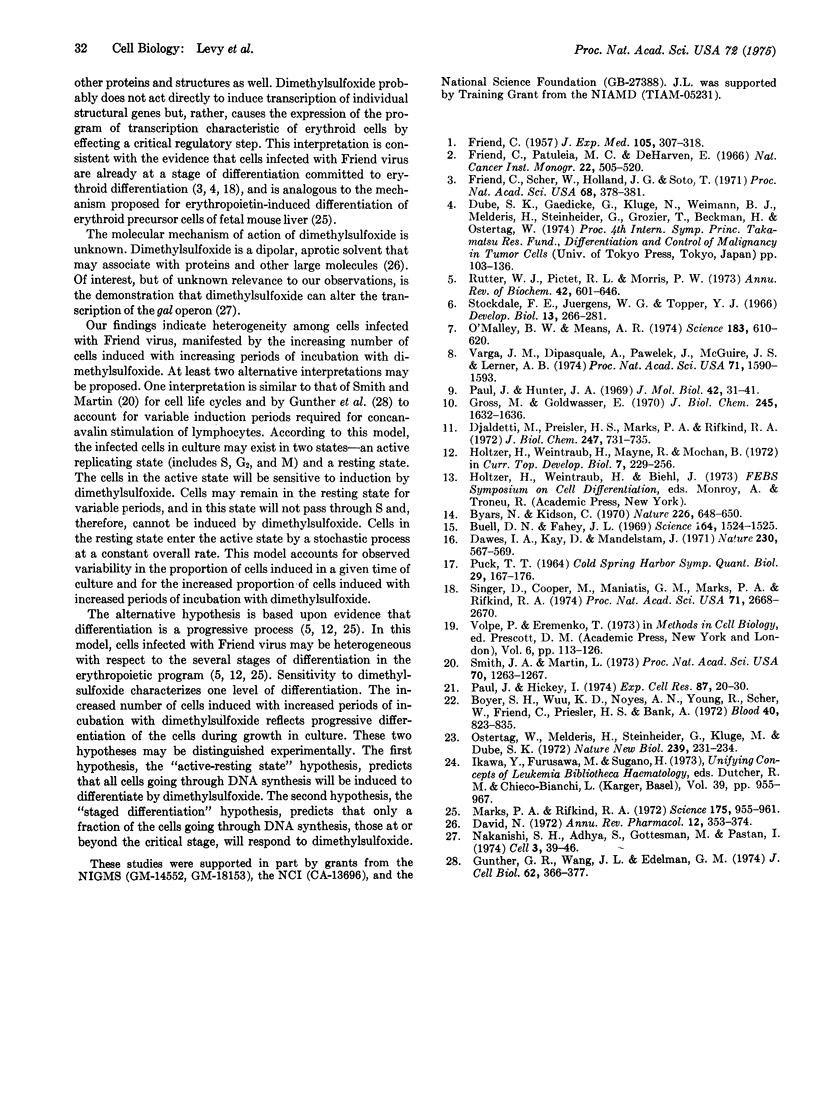Abstract
Cells infected with Friend virus can be induced to erythroid differentiation by culture with 2% dimethylsulfoxide. This study was designed to determine if dimethylsulfoxide causes the expression of erythroid differentiation by an effect on a particular phase of the cell division cycle. The infected cells were synchronized by exposure to 2 mM thymidine. It is shown that dimethylsulfoxide must be present during DNA synthesis (S-phase) and, possibly, shortly thereafter, to induce differentiation assayed by measuring hemoglobin synthesis. In order to achieve an effective intracellular incorporation of dimethylsulfoxide, cells must be exposed to the agent for at least 24-30 hr before the critical S phase. It is suggested that induction of erythroid differentiation in cells infected with Friend virus involves an effect of dimethylsulfoxide, or a metabolic product, that alters the program of transcription, during or immediately after DNA synthesis.
Full text
PDF




Selected References
These references are in PubMed. This may not be the complete list of references from this article.
- Boyer S. H., Wuu K. D., Noyes A. N., Young R., Scher W., Friend C., Preisler H. D., Bank A. Hemoglobin biosynthesis in murine virus-induced leukemic cells in vitro: structure and amounts of globin chains produced. Blood. 1972 Dec;40(6):823–835. [PubMed] [Google Scholar]
- Buell D. N., Fahey J. L. Limited periods of gene expression in immunoglobulin-synthesizing cells. Science. 1969 Jun 27;164(3887):1524–1525. doi: 10.1126/science.164.3887.1524. [DOI] [PubMed] [Google Scholar]
- Byars N., Kidson C. Programmed synthesis and export of immunoglobulin by synchronized myeloma cells. Nature. 1970 May 16;226(5246):648–650. doi: 10.1038/226648a0. [DOI] [PubMed] [Google Scholar]
- David N. A. The pharmacology of dimethyl sulfoxide. Annu Rev Pharmacol. 1972;12:353–374. doi: 10.1146/annurev.pa.12.040172.002033. [DOI] [PubMed] [Google Scholar]
- Dawes I. W., Kay D., Mandelstam J. Determining effect of growth medium on the shape and position of daughter chromosomes and on sporulation in Bacillus subtilis. Nature. 1971 Apr 30;230(5296):567–569. doi: 10.1038/230567a0. [DOI] [PubMed] [Google Scholar]
- Djaidetti M., Preisler H., Marks P. A., Rifkind R. A. Erythropoietin effects on fetal mouse erythroid cells. II. Nucleic acid synthesis and the erythropoietin-sensitive cell. J Biol Chem. 1972 Feb 10;247(3):731–735. [PubMed] [Google Scholar]
- FRIEND C. Cell-free transmission in adult Swiss mice of a disease having the character of a leukemia. J Exp Med. 1957 Apr 1;105(4):307–318. doi: 10.1084/jem.105.4.307. [DOI] [PMC free article] [PubMed] [Google Scholar]
- Friend C., Patuleia M. C., De Harven E. Erythrocytic maturation in vitro of murine (Friend) virus-induced leukemic cells. Natl Cancer Inst Monogr. 1966 Sep;22:505–522. [PubMed] [Google Scholar]
- Friend C., Scher W., Holland J. G., Sato T. Hemoglobin synthesis in murine virus-induced leukemic cells in vitro: stimulation of erythroid differentiation by dimethyl sulfoxide. Proc Natl Acad Sci U S A. 1971 Feb;68(2):378–382. doi: 10.1073/pnas.68.2.378. [DOI] [PMC free article] [PubMed] [Google Scholar]
- Gross M., Goldwasser E. On the mechanism of erythropoietin-induced differentiation. VII. The relationship between stimulated deoxyribonucleic acid synthesis and ribonucleic acid synthesis. J Biol Chem. 1970 Apr 10;245(7):1632–1636. [PubMed] [Google Scholar]
- Gunther G. R., Wang J. L., Edelman G. M. The kinetics of cellular commitment during stimulation of lymphocytes by lectins. J Cell Biol. 1974 Aug;62(2):366–377. doi: 10.1083/jcb.62.2.366. [DOI] [PMC free article] [PubMed] [Google Scholar]
- Holtzer H., Weintraub H., Mayne R., Mochan B. The cell cycle, cell lineages, and cell differentiation. Curr Top Dev Biol. 1972;7:229–256. doi: 10.1016/s0070-2153(08)60073-3. [DOI] [PubMed] [Google Scholar]
- Marks P. A., Rifkind R. A. Protein synthesis: its control in erythropoiesis. Science. 1972 Mar 3;175(4025):955–961. doi: 10.1126/science.175.4025.955. [DOI] [PubMed] [Google Scholar]
- Nakanishi S., Adhya S., Gottesman M., Pastan I. Effects of dimethylsulfoxide on the E. coli gal operon and on bacteriophage lambda in vivo. Cell. 1974 Sep;3(1):39–46. doi: 10.1016/0092-8674(74)90035-x. [DOI] [PubMed] [Google Scholar]
- O'Malley B. W., Means A. R. Female steroid hormones and target cell nuclei. Science. 1974 Feb 15;183(4125):610–620. doi: 10.1126/science.183.4125.610. [DOI] [PubMed] [Google Scholar]
- Ostertag W., Melderis H., Steinheider G., Kluge N., Dube S. Synthesis of mouse haemoglobin and globin mRNA in leukaemic cell cultures. Nat New Biol. 1972 Oct 25;239(95):231–234. doi: 10.1038/newbio239231a0. [DOI] [PubMed] [Google Scholar]
- PUCK T. T. STUDIES OF THE LIFE CYCLE OF MAMMALIAN CELLS. Cold Spring Harb Symp Quant Biol. 1964;29:167–176. doi: 10.1101/sqb.1964.029.01.021. [DOI] [PubMed] [Google Scholar]
- Paul J., Hickey I. Haemoglobin synthesis in inducible, uninducible and hybrid Friend cell clones. Exp Cell Res. 1974 Jul;87(1):20–30. doi: 10.1016/0014-4827(74)90522-9. [DOI] [PubMed] [Google Scholar]
- Paul J., Hunter J. A. Synthesis of macromolecules during induction of haemoglobin synthesis by erythropoietin. J Mol Biol. 1969 May 28;42(1):31–41. doi: 10.1016/0022-2836(69)90484-7. [DOI] [PubMed] [Google Scholar]
- Rutter W. J., Pictet R. L., Morris P. W. Toward molecular mechanisms of developmental processes. Annu Rev Biochem. 1973;42:601–646. doi: 10.1146/annurev.bi.42.070173.003125. [DOI] [PubMed] [Google Scholar]
- Singer D., Cooper M., Maniatis G. M., Marks P. A., Rifkind R. A. Erythropoietic differentiation in colonies of cells transformed by Friend virus. Proc Natl Acad Sci U S A. 1974 Jul;71(7):2668–2670. doi: 10.1073/pnas.71.7.2668. [DOI] [PMC free article] [PubMed] [Google Scholar]
- Smith J. A., Martin L. Do cells cycle? Proc Natl Acad Sci U S A. 1973 Apr;70(4):1263–1267. doi: 10.1073/pnas.70.4.1263. [DOI] [PMC free article] [PubMed] [Google Scholar]
- Stockdale F. E., Juergens W. G., Topper Y. J. A histological and biochemical study of hormone-dependent differentiation of mammary gland tissue in vitro. Dev Biol. 1966 Apr;13(2):266–281. doi: 10.1016/0012-1606(66)90068-6. [DOI] [PubMed] [Google Scholar]
- Varga J. M., Dipasquale A., Pawelek J., McGuire J. S., Lerner A. B. Regulation of melanocyte stimulating hormone action at the receptor level: discontinuous binding of hormone to synchronized mouse melanoma cells during the cell cycle. Proc Natl Acad Sci U S A. 1974 May;71(5):1590–1593. doi: 10.1073/pnas.71.5.1590. [DOI] [PMC free article] [PubMed] [Google Scholar]


